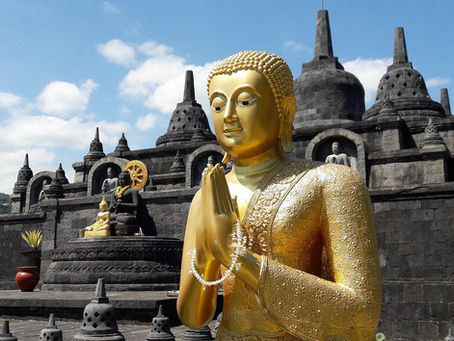top of page

GLOBAL SHANANIGANS

Search


Suan Dok Temple
Marked by the presence royal ashes, Wat Suan Dok was established in the 14th century on the grounds of a royal garden. Its tranquil exterior belies over six centuries of sacred history. Whitewashed chedis catch the northern Thai sunlight, standing as symbols of devotion, mortality and remembrance. Surrounding the central chedi, royal mausoleums enshrine Chiang Mai’s rulers, underscoring the temple’s role as a spiritual bridge between the living and the departed.
Shannon


Baan Dam - The Black House Museum
In the quiet north of Chiang Rai, where the air hums with memory and shadow, stands The Black House Museum, the unique brainchild of famed Thai artist Thawan Duchanee. This open-air gallery unfolds across tranquil gardens, where forty haunting structures rise like dark prayers. Within their walls, bones, taxidermy, and sacred art merge into a single, unsettling vision, a labyrinth of charred timber and silence, less a museum than a descent into the artist’s soul.
Shannon


Railay Beach
Hidden behind towering limestone cliffs on Thailand’s Andaman Coast, Railay Beach is a secluded paradise reachable only by boat. Nestled between Krabi and Ao Nang, this striking peninsula draws climbers to its rugged cliffs and sun seekers to its golden shores but beyond the postcard perfect scenery lies a rich history and a quiet, enduring spirit that has shaped the land long before it became a travel hotspot.
Shannon


Chiang Rai’s Blue Temple - Wat Rong Suea Ten
Wat Rong Suea Ten, known as the Blue Temple, commands attention with its striking sapphire and gold tones, a bold statement in Chiang Rai’s spiritual landscape. Finished in 2005, it rises on the site of a long-abandoned shrine, quietly reclaiming a space rich in history. Local artist Phuttha Kabkaew envisioned a temple that honours the elegance of traditional Buddhist art while pushing it into a contemporary realm, creating a design that feels both rooted in heritage and unmi
Shannon


Bale Kambang
Floating within the ruins of Klungkung Palace, Bale Kambang rises like a defiant island, a silent witness to centuries of ambition, devotion and blood soaked politics. Built when Bali’s unified kingdom splintered into warring courts, it is more than a royal relic, a fusion of power, spirituality and symbolic mastery. Its ceiling murals depict kings and gods walking the line between the mortal and the divine, while the surrounding waters reflect the cosmic ocean and the fragil
Shannon


Tiger Cave Temple - Wat Tham Suea
Hidden deep within the forest, the Tiger Cave Temple was founded in 1975 by a devoted monk seeking refuge from the world’s distractions. Drawn to the untouched serenity of the jungle, he discovered a secluded sanctuary where the whispers of the trees and the stillness of the air created the perfect environment for deep meditation. Amid shadowed caves and quiet trails, the temple rose as a place where nature, legend and spiritual devotion converge.
Shannon


Khao Sok National Park - Thailand’s Ancient Jungle
Declared a national park in 1980, Khao Sok in southern Thailand’s Surat Thani Province is a primeval wilderness frozen in time. Towering limestone karsts and winding rivers carve through a sprawling rainforest so ancient it once lay beneath a prehistoric ocean. At 160 million years old, Khao Sok’s evergreen rainforest offers travellers a rare glimpse into a world that has survived ice ages, shifting continents and humanity’s relentless march.
Shannon


Wat Chedi Luang
Commissioned under King Saen Muangma in the late 14th century, this ancient royal monastery stands among Chiang Mai’s most venerated temples. Originally envisioned as a monumental reliquary to honour and enshrine the ashes of his father, King Ku Na, it was to rise as a symbol of royal devotion and divine aspiration. Yet destiny had other plans.
Shannon


Wat MingMuang - The Temple of Crouching Elephants
Long ago, the land where Wat MingMuang now stands was a vast, fertile swamp, alive with dense reeds and winding waterways. Hidden within this wild sanctuary, majestic elephants roamed freely, revered as sacred symbols of power, wisdom and royalty. Amid this untamed beauty, the temple’s foundations were laid, a place where human devotion met the quiet majesty of nature, shrouded in the whispers of centuries past.
Shannon


Wat Rong Khun - The Temple of Light
Radiant in white and adorned with shimmering mirrors, the White Temple embodies the journey toward spiritual purity and enlightenment. Its gleaming surfaces symbolise Buddha’s divine wisdom, while the mirrored mosaics reflect the light of truth that dispels ignorance. Conceived as a visual meditation on the path to nirvana, Wat Rong Khun invites reflection on the struggle between temptation and purity that lies at the heart of the human experience.
Shannon


Wat Phan Tao - Temple of a Thousand Kilns
Tucked in the heart of Chiang Mai’s ancient walled city, Wat Phan Tao is a hidden gem often overlooked beside the towering Wat Chedi Luang. Its quiet teakwood halls exude history and calm, a rare glimpse into 14th-century life during the Mangrai Dynasty. Originally built as a residence for local monks rather than a grand temple, it invites visitors to step back in time and soak in a serene, meditative atmosphere.
Shannon


Wat Sri Suphan - The Silver Temple
Located among the narrow, winding lanes just south of Chiang Mai’s historic South Gate, Wat Sri Suphan stands as the dazzling centerpiece of the Haiya subdistrict, a historic residential area renowned for its traditional silver workshops. An inscription within the temple grounds reveals that the complex was originally built in 1501 during the reign of King Mueang Kaeo, the 11th ruler of the Lanna Kingdom’s Mangrai Dynasty.
Shannon


Brahmavihara Arama Buddhist Monastery
Perched 300 meters above Northern Bali’s hills, Brahmavihara Arama is the island’s largest Buddhist monastery, offering breathtaking views over rice terraces and the Bali Sea. Though built in the 1970s, this tranquil sanctuary has quickly become a must-visit spiritual retreat away from the usual tourist paths.
Shannon


The Royal Twin Pagodas
Perched atop the misty heights of Doi Inthanon National Park, the twin pagodas were built to honour the 60th birthdays of King Bhumibol Adulyadej and Queen Sirikit. Beyond their striking architecture, these sacred structures embody Thailand’s deep respect for the monarchy, the enduring strength of its Buddhist heritage and the unity of its people, standing as timeless symbols of reverence and national pride.
Shannon


Jame' Asr Hassanil Bolkiah Mosque
Constructed to honour Brunei’s Sultans and celebrate the 25th anniversary of Sultan Hassanal Bolkiah’s accession to the throne, the Jame’ Asr Hassanil Bolkiah Mosque dazzles with 29 gold covered domes and stands as one of Southeast Asia’s grandest Islamic monuments. Every corner of this royal mosque reflects faith, artistry and the enduring legacy of Brunei’s monarchy, creating a space where devotion and lavish architectural brilliance come together.
Shannon


Wat Chalong - A Temple of Healing & History
Rising near Phuket’s southern tip, Wat Chalong is the island’s largest and most revered Buddhist temple. Built in the early 19th century, it is famed for its association with monks who led the community to victory during the 1876 Chinese rebellion. Today, its golden spires and serene courtyards draw visitors from around the world, offering a glimpse into Phuket’s rich spiritual heritage.
Shannon


Wat Phra Singh - Temple of the Lion
Shrouded in centuries of legend, Wat Phra Singh rises in the heart of Chiang Mai’s Old City as a sanctuary of faith and mystery. Built in 1345 under Lanna King Phayu, it was created to guard a sacred Buddha relic and cradle the ashes of his father, linking royal legacy with divine purpose. Known as the Monastery of the Lion Buddha, its golden halls still echo with the chants of monks and novices drawn from across Southeast Asia, drawn by whispers of ancient power and the endu
Shannon


Co Loa Ancient Citadel
Dating back to 208 BC, Co Loa Citadel rose as the heart of the ancient Au Lac kingdom under the legendary King An Duong Vuong. Legend tells of a mighty crossbow and protective magic, yet even these could not save the kingdom from betrayal and ruin, a story of power, ambition and ghosts that still linger over the northern plains.
Shannon


One Pillar Pagoda
Regarded as one of Vietnam’s most iconic architectural treasures, the One Pillar Pagoda rises like a solitary lotus from the water. Built in 1049 AD by Emperor Lý Thái Tông and dedicated to Quan Âm, the Bodhisattva of Compassion, the shrine has long drawn worshippers seeking fertility, health and divine favour, its slender silhouette a silent witness to a millennium of faith and history.
Shannon


The Temple of Literature
Founded in 1070 AD under Emperor Lý Thánh Tông, the Temple of Literature honours Confucius and his disciples, its courtyards, banyan trees and lotus ponds echoing centuries of scholarly pursuit. Later home to Vietnam’s first university, it carries the weight of history and the whispered presence of generations of students, a place where wisdom feels alive, shadowed by the spirits of those who once walked its paths.
Shannon
bottom of page